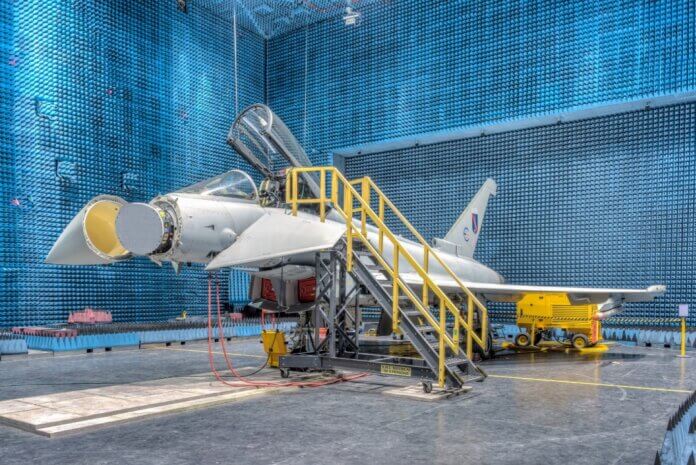
AESA radars are generally considered to be the most innovative and technologically-advanced type of tactical radar system and have become almost a necessity for modern fighter aircraft.
All new generation fighters are built with Active Electronically Scanned Array (AESA) radar, and many older fighters have been or are being retrofitted with AESA radars.
Conventional mechanically-scanned (M-scan) fighter radars use a moving antenna, which is steered or repositioned mechanically in order to ‘steer’ the radar beam. This requires complex and powerful mechanisms to move the antenna quickly and precisely, sometimes under high g-loadings.
These traditional M-scan radars produce a single radar beam and usually operate on fixed frequencies – often with relatively limited frequency agility. There is no ability to simultaneously operate in both air-to-air and air-to-ground modes. Traditional radars also use a single transmitter/receiver, making them potentially vulnerable to unreliability, with a number of ‘single-points-of-failure’.
Radars with electronically scanned or ‘phased’ arrays use electronic phase shifting to steer the transmitted radar ‘beam’, using timing differences between the signals from each element to form and steer the radar beam, rather than physically moving the antenna.
There are two types of electronically scanned or phased array radar – passive and active (PESA and AESA), but PESA radars have relatively modest range and are often heavy and prone to cooling problems. PESA radars are today often viewed as representing a technological dead end, and it is AESA radars that now dominate the fighter radar market. So what is an AESA radar, and why is AESA technology becoming so ubiquitous?
First-look, First-shot, First-kill
Fundamentally, air combat is all about killing the enemy without being killed yourself, what Lockheed Martin has called a “first-look, first-shot, first-kill capability.” That means seeing an enemy aircraft first, and being able to fire a missile and destroy the target without the enemy pilot seeing you and without him getting off a return missile shot.
All sorts of things feed into that capability, including your own radar cross section, the range of your missile armament, and rules of engagement, but radar is fundamental to the ‘first look’ part of the phrase above. Your radar must locate the enemy aircraft in three-dimensional space with sufficient accuracy to be able to engage, providing what is called a ‘weapons quality track.’ Most agree that AESA radars achieve this better than conventional mechanically scanned arrays.
Most AESA radars use a fixed antenna, consisting of a matrix of multiple solid state transmit/receive modules (TRMs), each of which effectively functions as an individual antenna capable of generating and radiating its own independent signal.
The AESA radar antenna array can be divided into sub-arrays that are capable of adaptive beam-forming, including the generation of multiple independent beams. These beams may be interleaved, allowing the radar to support multiple simultaneous radar modes, including air-to-air search-and-track, ground moving target indication and tracking, real beam mapping, synthetic aperture radar (SAR) mapping, and sea surface search. In a two-seat aircraft like the Boeing F/A-18F Super Hornet, this means that the pilot in the front cockpit could be undertaking an air-to-air task, while the weapons systems officer in the aft cockpit is simultaneously prosecuting an air-to-ground attack, with the radar supporting both.
An AESA radar will typically make a raster-type scan but using a thin pencil beam – giving a narrower and more elongated main lobe than a typical mechanically scanned radar. Because it can scan at a very high rate it can produce more power in this more ‘dense’ lobe, and with reduced latency. But because it can produce multiple beams it does not have to wait for a scanning beam to revisit a target. Instead, an AESA radar can prioritise and scan around the first detection or ‘hit’ and build track information rapidly, giving a higher quality track at longer range. Alternatively, one beam may be ‘frozen’, or can be kept pointing at a target continuously rather than returning to that target with each raster scan, while other beams scan elsewhere. This improves resolution and allows multiple targets to be tracked continuously, or for spatially separated targets to be tracked without any degradation in performance.
An AESA radar will typically change its frequency with every pulse, generally using a random sequence, and can also spread their signal emissions across a wider range of frequencies, making it harder to detect, locate or jam. This, together with the fact that an AESA does not have a fixed pulse repetition frequency makes it a low-probability of intercept (LPI) radar – ‘stealthier’ than conventional fighter radars.
The individual TRMs operate at relatively low power, and can be carefully tailored, using no more transmitting power than is needed to obtain the required information for each individual target. This obviates the need for a large high-voltage power supply, and further reducing the chances of the radar’s signals being intercepted by hostile forces.
Because each module operates independently, the failure of a single TRM will not have a significant effect on overall system performance. Even the failure of a number of modules will not prevent the radar from operating, but will rather result in a ‘graceful degradation’ of performance. And the scope for failure is lower than with a traditional radar, because the lack of moving parts significantly improves reliability, and reduces costs of ownership.
Many current AESA radars are not much heavier than moving planar arrays, early models, and are better able to work with existing aircraft power and cooling. Some now represent something close to a plug-and-play upgrade option, though generally an AESA radar will require some increase in cooling and electrical power generation capacity, and often some strengthening of the forward fuselage.
Modern fighter radars are expected to do more than simply locate and identify airborne targets and support missiles in flight. AESA antennas can also be used to create high-bandwidth data links between aircraft and other equipped systems, and advanced AESA radars may also offer a useful electronic attack capability.
The AESA radar does have one notable disadvantage — its limited field of view (FOV). Currently, the maximum FOV for a standard flat phased AESA antenna is between 90 and 120 degrees. But, by combining mechanical movement with the system, the limited AESA radar range can be vastly increased.
AESA Models
The first American AESA radar was the Raytheon AN/APG-63(V)2, a major upgrade for some 18 US Air Force Boeing F-15C aircraft based at Elmendorf Air Force Base, Alaska, which combined the proven AN/APG-63 ‘back end’ with a new AESA antenna. They entered service in 1999.
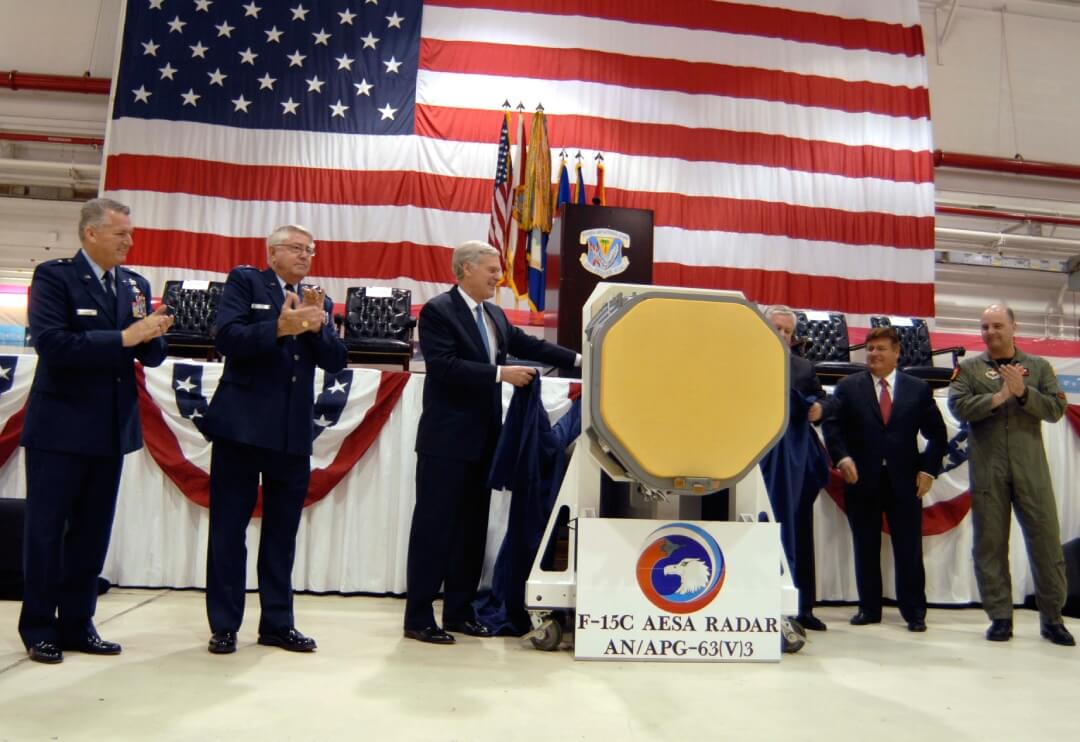
The first operational all-new fighter AESA was Mitsubishi Electric’s ground-breaking J/APG-1. Designed and built for use on the Mitsubishi F-2 fighter, which entered service in 2000, the J/APG-1 was the first series production AESA to be introduced on an in-service military aircraft. The upgraded J/APG-2 brings compatibility with the new Mitsubishi AAM-4B air-to-air missile.
The AN/APG-63(V)3 radar is a more modern variant of the APG-63(V)2 and uses the same AESA technology used in Raytheon’s APG-79. The (V)3 radar is currently being retrofitted into the F-15C/D and deployed in Singapore’s new build F-15SG and Saudi Arabia’s new F-15SA aircraft. The radar provides air-to-air and air-to-surface capabilities, enabling the detection and engagement of targets over long distances.
The AN/APG-82 was designed for the modernisation of the USAF’s F-15E aircraft fleet, and uses the APG-63(V)3’s antenna and the upgraded processor of the APG-79. These upgrades ensured extended range, precision engagement capabilities and better multi-target tracking. The APG-82 is used on the IDF/AF’s F-15I and the JASDF’s F-15J upgrade as well as on the USAF’s upgraded F-15Es.
The AN/APG-79 is an upgraded version of the M-Scan APG-65 and APG-73 family, with an AESA antenna with more than 1000 transmit/receive modules TRMs and was built using open systems architecture and commercial-off-the-sheet parts.

Raytheon was the prime contractor for the new radar, with Northrop Grumman responsible for the design and supply of the X-Band phased array antenna. It was designed to give Boeing’s F/A-18E/F Super Hornet an AESA radar, and is claimed to provide a near instantaneous and multi-target tracking capability. Some Super Hornet pilots have praised its ability to operate in the air-to-air and air-to-ground modes simultaneously, although early reports from Director, Operational Test and Evaluation (DOT&E) questioned its performance and reliability.
A scaled version of the APG-79, the (V)4 is being used for an upgrade of USMC ‘Heritage Hornets’ (F/A-18A-D) and implements Gallium Nitride, or GaN, technology, giving longer range and enhanced performance.
Northrop Grumman’s first major fighter AESA was the AN/APG-80, developed for use on the advanced Lockheed Martin Block 60 F–16E/F for the United Arab Emirates. Though based on the Westinghouse (now Northrop Grumman) AN/APG-68, the new AESA variant marked such a major step forward that many viewed the new F-16 variant as being a better aircraft than those flown by the USAF. After delivering some 80 F-16E/F aircraft to the UAE, the US Government eventually placed a ban on any further APG-80 exports – even to the UAE, its original customer, who had funded its development, killing off a planned top up buy of Block 61 aircraft!
An agile beam radar (ABR), using Northrop Grumman’s fourth-generation transmitter/receiver technologies, and fitted with about 1000 transmit/receive modules, the APG-80 is capable of simultaneously tracking air-to-air and air-to-ground targets and operating in the terrain-following mode.

The AN/APG-77 built further on Northrop Grumman’s experience in the AESA radar sector, and is the long-range, multi-function, low probability of intercept (LPI) radar fitted to the Lockheed Martin F-22 Raptor. The APG-77 provides the F-22 with a primary sensor that complements the aircraft’s LO stealth characteristics, allowing the Raptor pilot to track and engage multiple airborne threats before any adversary radar can detect the F-22.
The solid-state radar has 1956 transmit/receive modules, each the size of a stick of chewing gum, and can perform near-instantaneous beam steering (in the order of tens of nanoseconds), though the original model had a 50:50 mix of separate single-function transmit modules and receive modules. The APG-77 attained initial operational capability (IOC) in 2006 and there are more than 180 systems in service. The improved APG-77(V)1 provides full air-to-ground functionality (high-resolution synthetic aperture radar mapping, ground moving target indication and track (GMTI/GMTT), automatic cueing and recognition, combat identification, and other advanced features).
The Lockheed Martin F-35’s AN/APG-81 radar was commissioned in 2005 and uses technology and some modes from the F-22’s AN/APG-77. Northrop Grumman describe the APG-81 as “the latest and most capable AESA in the world” and note that it acts as the “cornerstone to the F-35 Lightning II’s advanced sensor suite.” They say that it: “provides unparalleled battlespace situational awareness that translates into lethality, aircrew effectiveness and survivability.”
In addition to the usual air-to-air and air to-ground capabilities (including an ultra-high-resolution Synthetic Aperture Radar (SAR) mapping mode), the APG-81 can also operate as an EW aperture using the AESA’s multi-function array (MFA) to transmit powerful jamming signals with great precision for electronic protection (EP), electronic attack (EA) and electronic support measures (ESM), and enables the F-35 to suppress and destroy advanced enemy air defences.
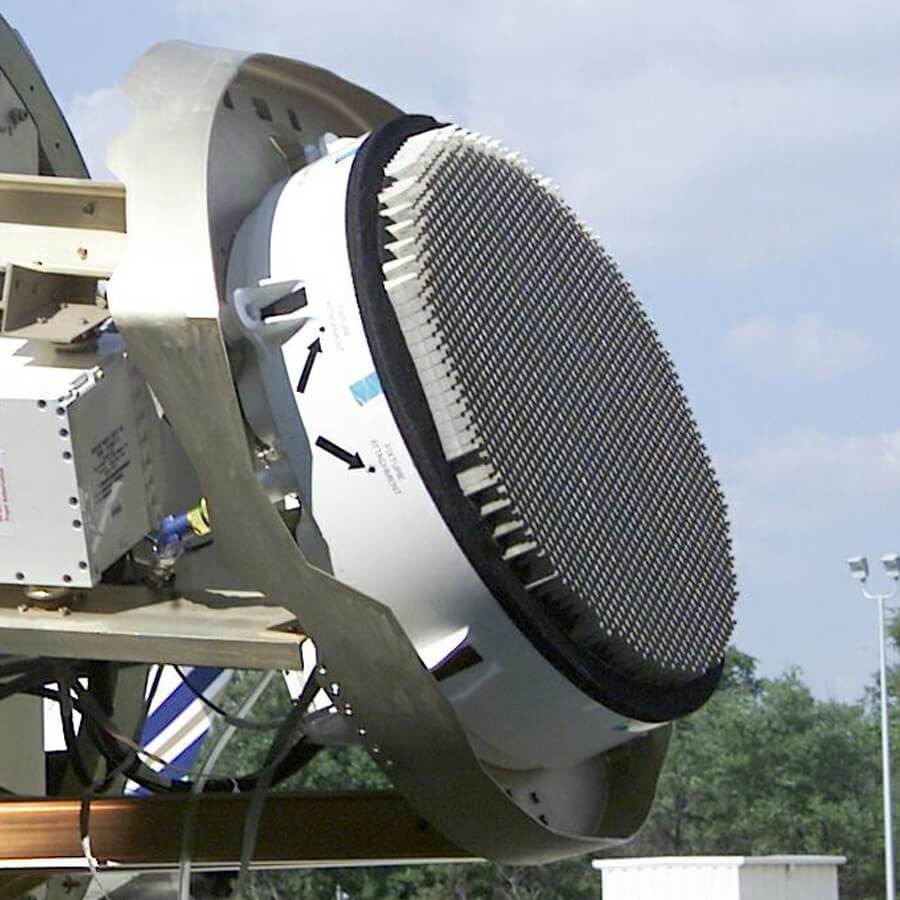
The most recent US fighter radars were both developed to meet 4th Generation Fighter (and especially F-16) upgrade requirements. The Raytheon Advanced Combat Radar (RACR) or AN/APG-84 was a scaled-down version of the AN/APG-79 already operational on F/A-18E/F Super Hornet and Boeing EA-18G Growler, and was selected for the original RoKAF F-16 upgrade, which was subsequently cancelled. Since then, it seems to have gained no real traction.
Up to now, the Northrop Grumman Scalable Agile Beam Radar (SABR) or AN/APG-83 has enjoyed more commercial success. Derived from the F-22’s APG-77 and the F-35’s APG-81, SABR is designed to fit into the F-16 aircraft with no power, structural or cooling modifications, and was selected for a number of USAF and export F-16 upgrades, and now forms the basis of the latest Block 70 F-16.
Northrop Grumman says that the SABR radar will “ensure F-16s, F/A-18s and other 4th generation aircraft remain operationally viable and sustainable for decades to come.” The new radar provides faster search and target acquisition, smaller target detection, multi-target tracking, autonomous, maritime modes, all-environment stand-off precision targeting, ‘BIG SAR’ wide area, high-resolution mapping, high quality co-ordinate generation, as well as robust electronic protection and interleaved mode operations. As well as providing greater situational awareness, SABR is claimed to give three to five times greater reliability and availability.
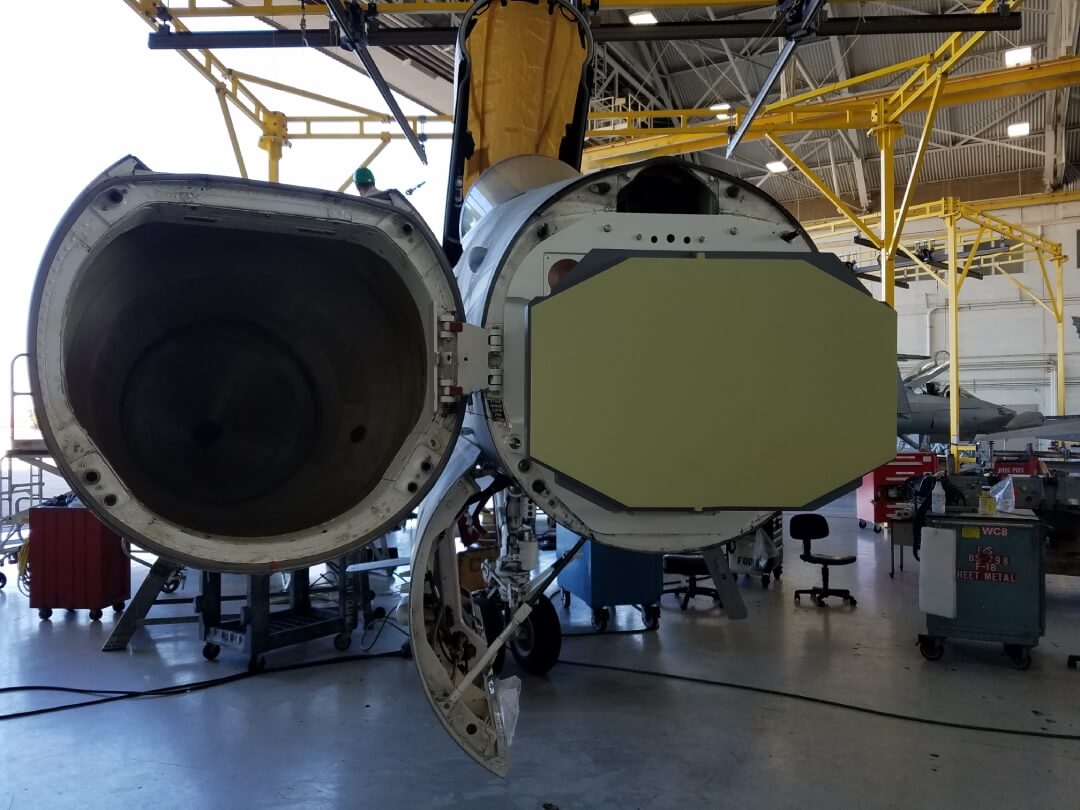
Though Europe’s fighter operators have been relatively slow to adopt AESA radar, Anglo-Italian radar giant Leonardo (and its precursor companies) have been at the forefront of AESA development for some years. Leonardo’s ground-breaking Vixen 500E AESA entered service with US Customs and Border Protection (CBP) in 2012, for example. The radar was fitted to the CBP’s Cessna C-550 Citations, which were used to intercept drug-running aircraft. The Vixen 500E offered superior air-air detection and automatic tracking capabilities, particularly against small targets (including microlights) even over varied difficult terrain.
Leonardo’s Grifo radar family now includes an AESA variant in the form of the Grifo-E. Grifo-E uses Leonardo’s proven E-scan antenna technology and the new multi-aperture array and multi-channel receiver provide a wider set of advanced and up-to-date capabilities. With its modular architecture the radar is also easily customisable and can be adapted and integrated with many different platforms.
Leonardo’s next fighter AESA was a real game-changer. The Vixen 1000E (later redesignated as the ES-05 Raven) features an innovative roll-repositionable AESA antenna providing a full ±100º field of regard – or roughly twice what fixed arrays provide. This Wide Field of Regard (WFoR) allows the aircraft to turn away after a missile launch while still maintaining support to the missile in flight. The single-axis, single-jointed, rotating barrel-type antenna repositioner requires the use of innovative connectors between the antenna and the back end of the radar, and these were based on technology used in oil drilling.
Fitted to the Saab Gripen E/F, Raven is optimised for multi-role operations, and includes a comprehensive suite of modes for both air-to-air and air-to-ground operation including interleaved operation.
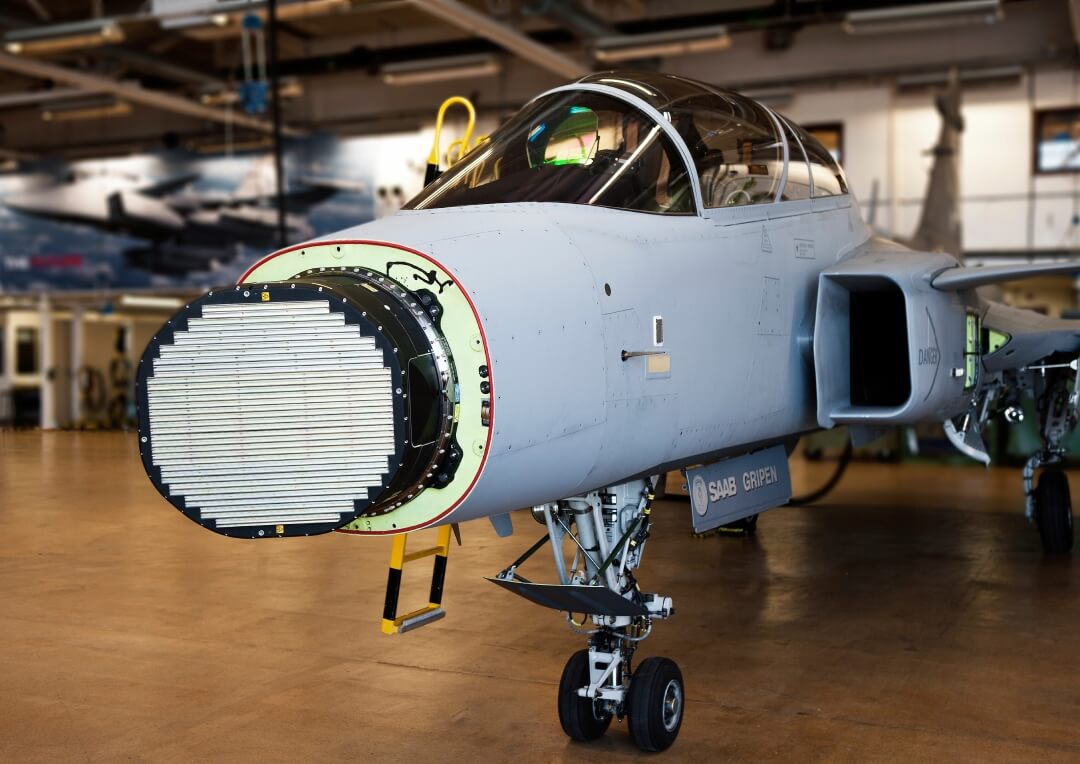
Eurofighter – M-Scan to AESA
Eurofighter was slow to embrace AESA technology, probably because the mechanically scanned Captor radar was the most advanced ‘M-scan’ radar in the world, with a lightweight antenna, big, powerful motors and robust gimbals, which allow it to be repositioned very rapidly and with great precision. It can intersperse the search pattern with ‘loopbacks’ to hit high-priority targets, rather than being stuck in a constant raster scan pattern like many conventional mechanically scanned radars. When Typhoon was being conceived, Euroradar believed that AESA was not really ready but that commercial RF technology would make it a less costly and more efficient upgrade option, or as a new radar for late production aircraft.
As recently as November 2018, an experienced Luftwaffe Typhoon pilot told this writer that he hadn’t found himself “in one situation where I wanted or needed E-scan.”
He highlighted the excellent performance and capability of the M-scan radar on the Eurofighter and stressed that he would rather have the EuroFirst passive infrared airborne track equipment infrared search-and-track (PIRATE IRST), which was absent on German Eurofighters, than a new radar, and that after that he’d rather augment the existing radar with a Litening laser designator pod (LDP) to give a passive long-range visual identification capability.
By contrast some UK Royal Air Force (RAF) Typhoon pilots (who have long had both Pirate and Litening) view M-scan radar as being on the verge of complete obsolescence, since mechanically scanned radars exhibit an inherently greater vulnerability to jamming and suffer from an inability to fully exploit the performance and capabilities of new weapons, including the Meteor BVRAAM.
Leonardo has developed the next-generation Leonardo Captor-E AESA radar, which is equipped with a dual swashplate mechanical re-positioner to give improved angular coverage and performance, and this is now entering service with the Kuwait Air Force in ECRS.Mk0 form. This radar will also equip Qatari Typhoons, while the improved ECRS.Mk 1 will equip upgraded German and Spanish Typhoons and any new build aircraft for Germany, including the 38 aircraft ordered under the Quadriga contract. At step zero ECRS.Mk 1 will be a licence-built ECRS.Mk 0, with a German-produced array. At step one, a new multi-channel receiver will be integrated, together with additional processing. Multi Channel capability will then be enabled under ECRS.Mk 1 step two.
The UK is pursuing an even more advanced AESA for some of its Typhoons. Though Leonardo’s ECRS.Mk 2 is often described as a member of the Captor family, the new radar, previously known as ‘Radar Two’ has no hardware commonality with the earlier variants, and is all-new from the power supply forward. Even the antenna uses a completely different type of repositioner, closer in design to that of the Raven than that used by ECRS.Mk 0, though it will provide the same very wide field of regard. The new Typhoon radar promises to bring new electronic attack capabilities, and will be transformational in BVR air combat. Some claim that it will be the world’s most advanced fighter radar when it enters service in 2028.
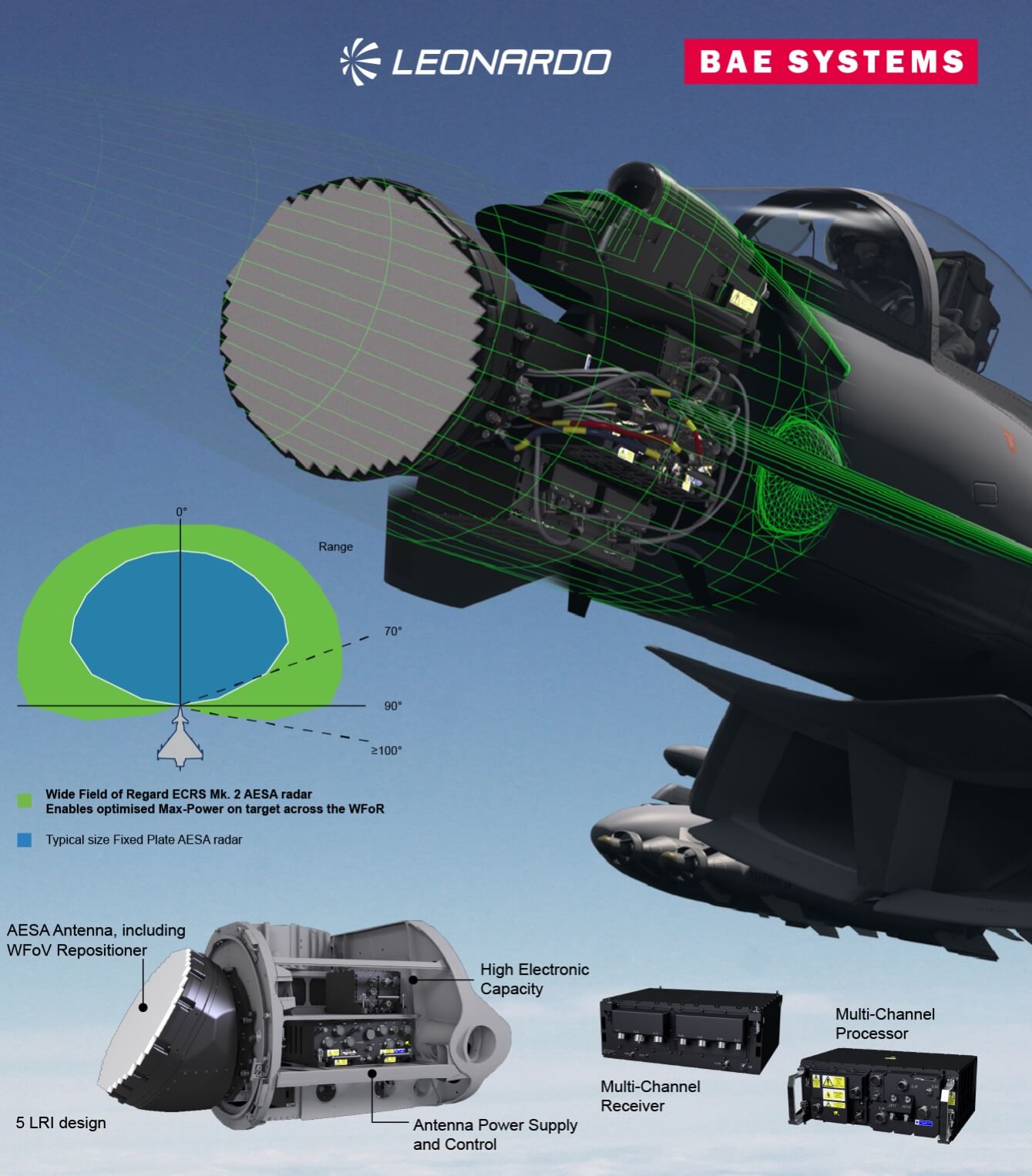
The French Rafale was originally delivered with the Thales RBE2, a PESA radar which nevertheless demonstrated an impressive ability to operate in air-to-air and air-to-ground modes simultaneously, and had serviceability and reliability advantages compared to mechanically scanned radars. But the drawbacks of PESA radar led to the rapid development of the RBE2AA, an AESA variant of the original RBE2 PESA radar, and as a result Rafale had an operational AESA radar by 2014. The small size of the Rafale’s nose means that this has only about 830 TRMs, however, roughly half the number used in the Typhoon radar, for example.
Though Sweden’s Gripen-E uses the Leonardo Raven, Saab has developed an indigenous GaN-based AESA radar which it flew in April 2020, and which it has offered as an upgrade option for the Gripen-C/D.
Though Russia actually fielded the first in-service fighter to use an electronically scanned radar, the Mikoyan MiG-31 ‘Foxhound’s Tikhomirov (NIIP) BRLS-8B Zaslon radar used a passive electronically scanned array (PESA), as did the NIIP N011M Bars used by the Su-30MKI, and the N035 Irbis radar fitted to the Su-35BM.
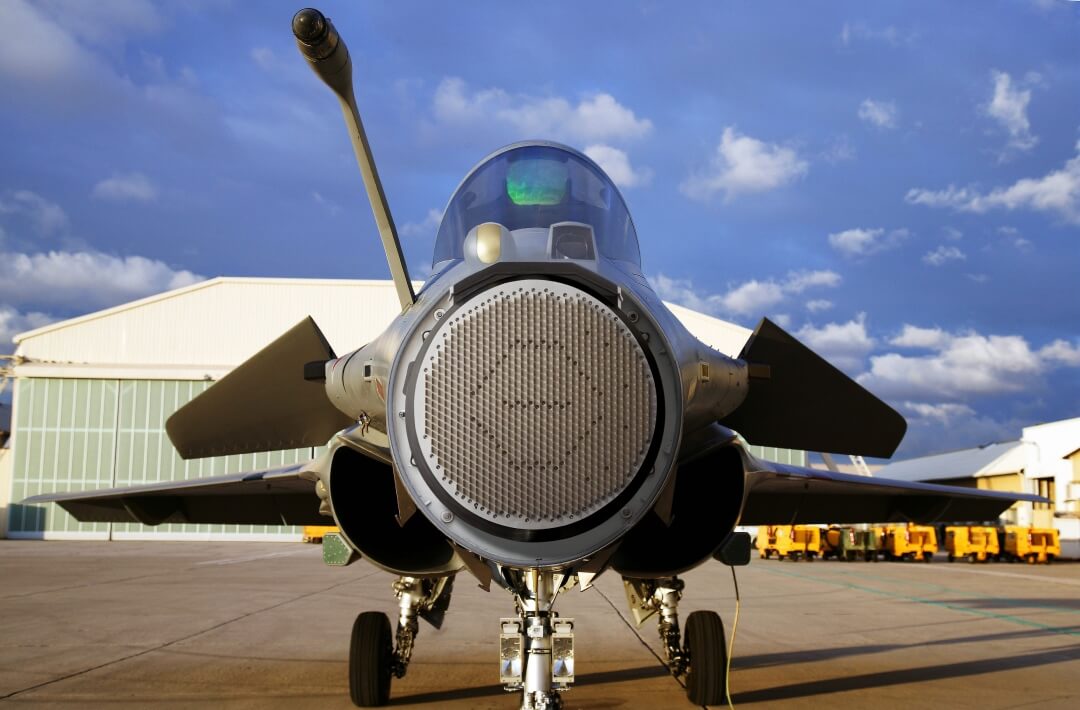
NIIR Phazotron has developed a number of AESA version of its Zhuk radar, but none have been fielded, while the Tikhomirov NIIP N036 Byelka has yet to enter full service on the Sukhoi Su-57.
The exact status of China’s AESA radar programmes is unclear. The Shenyang J-16 (an Su-27/30 derivative) is understood to have an AESA radar and is in the final stages of OT&E.
Later variants of the indigenous Chengdu J-10 are also thought to be equipped with an NRIET KLJ-10 AESA radar. Two AESA variants of the older KLJ-7A (Type 1478) radar have been associated with the new JF-17 Block-3, one of them fitted with a mechanical repositioner, and one with two auxiliary lateral antenna arrays to increase field of view.
The latter is the solution used by the Type 1475 radar on the Chengdu J-20 heavyweight fighter.
Elsewhere, Israel’RBE2s ELTA has produced the EL/M-2052 AESA radar, sold to India for its DARIN III Jaguar upgrade, and for the indigenous Tejas fighter. India’s Defence Research and Development Organisation (DRDO) and its subsidiary, the Electronics and Radar Development Establishment (LRDE), are developing an indigenous AESA radar, the Uttam, for future Tejas variants, and for planned upgrades to the Sukhoi Su-30MKI and Mikoyan MiG-29K.
In South Korea Hanwha Systems has developed a largely indigenous AESA radar for the new KAI KF-21 Boramae fighter. An indigenous Aselsan AESA radar is also understood to be under development for a Turkish F-16 upgrade, and for the new MMU fighter programme. It is expected to be ready by 2022-23. Aselsan has said that it expects the new radar to enjoy a performance similar to the Northorp AN/APG-83 AESA being fitted as part of the F-16V Viper upgrade and to new-build Block-70/72 F-16s.
In the future, it is unclear as to whether we will see a new generation of improved fighter radars, or a wholly new kind of much more integrated sensor.
If we see new versions of standalone radars, we can expect them to embody the best and most advanced features of the current generation – perhaps repositioners, and probably making increased use of Gallium Nitride (GaN) semiconductors, which has a broader amplification range than Gallium Arsenide (GaAs) dispersing heat more rapidly even at extremely high voltage levels.
Future AESA radars could incorporate additional conformal arrays to increase angular coverage, such antennas having been considered for the Su-57 and for the Rafale, among other types. Leonardo has shown the way forward with its Osprey surveillance radar, which uses up to four fixed conformal arrays to provide up to 360° azimuth coverage for a range of rotary- and fixed-wing platforms.
But others believe that next generation fighter sensors are likely to be more closely integrated and much less federated – like the Leonardo UK led Integrated Sensors And Non-Kinetic Effects and Integrated Communication System (ISANKE & ICS) of the Tempest fighter that will sit at the heart of the UK’s Future Combat Air System (FCAS). This will probably see a configurable mix of multi-purpose sensors spread around the aircraft, simultaneously sensing and tracking enemy aircraft, incoming missiles and other threats from all directions, while being fully integrated with a forward-facing radar. This radar was initially referred to as the Multi-Function Radio Frequency System (MFRFS), which was originally said to be “four times as accurate as existing radars in one tenth of the package.” It was claimed that the new radar would be able to collect as much data per second as the city of Edinburgh’s internet traffic, with powerful signal processors then processing that radar data to produce a comprehensive picture of the battlespace for the pilot.
by Jon Lake and Angie Bee













